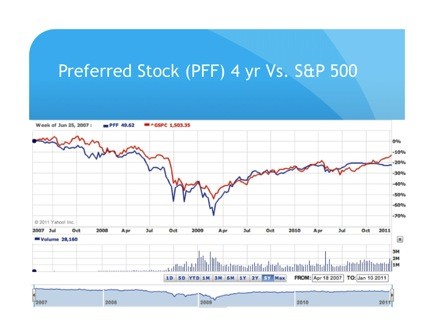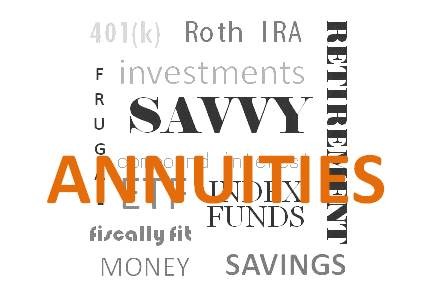How preferred stocks add income to your retirement portfolio
Post on: 18 Апрель, 2015 No Comment

MichaelFabian
Michael is a managing partner at FMD Capital Management. a fee-only registered investment advisory firm specializing in exchange-traded funds. Michael is the leader of the FMD investment committee where he implements actively-managed income portfolios using ETFs, mutual funds and closed-end funds. His investment philosophy is aimed towards designing portfolios that are low in volatility while still providing a high income stream, then shift in response to changing market environments. He also implements active risk management practices to protect his investors from ultimately experiencing a large loss. He regularly contributes his views on wealth management in his company blog. podcasts and special reports. You can follow Michael on Twitter @fabiancapital or email him at Michael@fmdcapital.com.
Michael ‘s Latest Posts
For nearly a year preferred stocks have been in what could be labeled as the perfect storm of stable to falling interest rates and solid stock market performance.
So far year to date many individual preferred stocks and preferred stock ETFs have outperformed the Standard & Poor’s 500 Index SPX, +1.26% and done so with much less overall volatility. Which raises the question: Do you need preferred stocks in your retirement income portfolio, and what category should they fall into as part of your diversified approach to investing?
When evaluating an investment in preferred stocks it’s clear the value proposition is in the high distribution yields and relatively low volatility. For these very reasons, I believe preferred stocks can be an excellent option for investors seeking to supplement an income gap with a portion of their portfolio, or searching for a noncorrelated asset class that will react differently to changing market dynamics. Managing an income gap in retirement is never easy, and with yields falling on many high dividend stocks due to recent outperformance, the number of options for high income streams are deteriorating.
Deciding how much exposure you should ultimately add to your portfolio is an important consideration. For clients in our Strategic Income Portfolio, we categorize our preferred stock exposure as part of the alternative or hybrid income sleeve .While that alternative sleeve can expand to as large as 20% of our total investible assets, our target figure for preferred stock exposure is currently in the neighborhood of 5% of our total portfolio. Yet I wouldn’t hesitate to increase that to 8%-10% if prices were to become extremely attractive.
Preferred stocks are somewhat unique in that they can respond to fluctuations in both interest rates and equity markets. They are often referred to as a hybrid asset class due to their characteristics of both equity and debt. For example, most preferred stocks are issued with a par value, maturity date, and/or call features attached to the individual security.This gives the issuing corporation the ability to call the shares back if the interest rate environment is conducive to refinance the outstanding equity at a lower dividend yield.That same company might even opt to swap preferred equity for debt or visa-versa to extend or shorten their refinancing cycle.
Investors should bear in mind that some preferred stocks can be issued with maturity dates as long as 30 years, which can cause them to react to interest rate changes or present volatility that is similar to long duration Treasury bonds. As a result, preferred stocks can only appreciate so far from their original par value due to call risks, interest rate risks, and other debt related attributes.
On the other hand the individual security is still an equity instrument issued by the corporation, but unlike common stock, preferred stock is higher on the capital structure yet doesn’t share in the earnings growth of the corporation. In turn, the preferred stock will exhibit price gyrations that foreshadow the underlying health of the balance sheet and abilities of the company to make good on its obligations. Furthermore, since preferred stocks are predominantly issued by banks, insurance companies, and utilities, the health of the underlying economy is an important consideration. Interestingly enough, many of these institutions can issue multiple classes, or series of preferred stock. So when researching individual names, be mindful there may be more than one series issued by a single corporation.
Putting the sum of the parts together, the best time to purchase preferred stocks is after a swift rise in interest rates, or following an economic set back that subsequently brings down prices closer to par value or below. Establishing a position near par value is important, since premium and call risk is greatly diminished.With good future economic prospects, it’s also likely the underlying company’s common stock will trade well which should further buoy the price of the related preferred shares.
For investors seeking to remove the individual security selection process, analysis, and guesswork, an easy way to add diversified exposure to your portfolio is through the iShares Preferred Stock ETF PFF, -0.10% the largest and oldest index based offering. Although there hasn’t been much innovation since the launch of PFF, there are some other decent options such as the PowerShares Preferred Stock Portfolio PGX, +0.07% or the Market Vectors Preferred Stock ex-Financials ETF PFXF, +0.01% .

Keeping preferred stocks on your investment radar should allow you to increase your income stream if you have fresh capital to deploy, or shift your portfolio dynamic if you find yourself overexposed to common dividend paying equities.
Although now doesn’t present the most opportune moment given the recent relative outperformance and spread to par on many preferred names, investors could consider starting with a small allocation with plans to add to it over time. More opportunistic investors could choose to wait for a correction to take place similar to what we experienced following the interest rate backup in 2013 to ultimately make their first purchases.
As always, developing a plan and then implementing it decisively will always produce the best results.
DISCLOSURE: FMD Capital Management holds both PFF and FMD in client accounts.
Michael Fabian is a managing partner at FMD Capital Management. a fee-only registered investment advisory firm specializing in exchange-traded funds.
More from RetireMentors:














